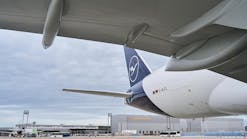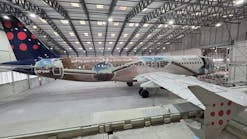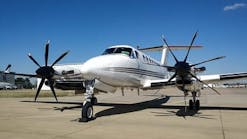By Gary Schmidt
Corrosion has long been recognized as one of the great enemies of the aircraft owner. Much has been said and written about corrosion in general aviation, but most of it pertains to airframe corrosion. Products and procedures have been developed to address this threat. Unfortunately, less has been done about internal engine corrosion. We may be totally unaware of any corrosion until the engine is torn apart for an overhaul – an overhaul that may need to be done hundreds of hours earlier because of corrosion damage.
The purpose of this article is to help raise awareness of this problem by presenting some of the current information available including various opinions of industy experts. What is offered here is primarily based on reports already published in the field. Through this discussion, we hope to stimulate more study in the area.
As we discuss corrosion in this article please keep in mind we are dealing only with internal engine corrosion.
What is corrosion?
The average person knows the most common version of corrosion as "rust." The word itself is either a noun or verb. Rust by definition is the result of the oxidation of metal. One engine manufacturer refers to the process of corrosion in aircraft engines as "galvanic corrosion" which is a type of corrosion caused by dissimilar metals being in close proximity of each other. In this process an electrolyte such as water also needs to be present. Almost all metals will oxidize or corrode. Leave one of your tools outside and shortly after a rain you will see rust unless it has a protective coating such as oil or paint. In an aircraft engine, however, it’s much more complicated than that.
Early in this research project, it was clear that there is little agreement on many facts relating to aircraft engine corrosion. There are even facts that go completely against popularly held opinions. The first and most obvious is the popular adage "oil and water don’t mix." More on that later.
Serious interest in the subject of of internal engine corrosion is a relatively recent phenomenon. In the past, many assumed that because the internal parts of the engine were coated with oil, corrosion would not occur. Further, if there was a danger at all, corrosion would raise its ugly head only when the engine was not run for very extended periods of time because the oil drained down to the sump and exposed the metal. Today we know that it can occur within a matter of days between engine operations and that it can even occur with oil coating the metal part.
Who is affected?
Generally every aircraft engine is in danger of corrosion. Some, however, are at a higher risk than others. The four factors to consider regarding which engines are affected relate to the age of the engine, its geographic location, how engines are operated when in use, and most importantly, its frequency of use.
These four engine factors can be broadly separated into two categories: "active" engines and "inactive" engines. We need to note here that Continental further distinguishes "inactive" with its definitions of "temporary storage" and "indefinite storage," the difference being "temporary" is not flown 30 to 90 days and "indefinite" means 90 days and longer.
Let’s explore for a moment, what is considered an "active" engine, or one "run regularly." It requires a very short research effort to quickly get the message that there is no clear definition. A sampling of the time periods used when discussing the subject of aircraft engine corrosion (often from the same document) varies from two days, one hour per week, 100 hours per year, 30 days, 90 days and once every two weeks. Naturally, different circumstances affect the time period but it seems that if one were to insist that experts use only one number, it likely would be 30 days.
Beginning with the day the brand new engine comes out of the factory, it finds itself on the corrosion hit list and this vulnerability to damage is addressed by the manufacturer. Continental states that if the engine is not run within six months after it leaves the factory, it should be re-treated for protection against corrosion. Its web site states, "Following acceptance testing, all engines are preserved by TCM prior to shipment. This preservation has a shelf life of six months after which the engine must be re-preserved for corrosion protection until the engine is placed into service."
Manufacturers recommend that the new engine break-in be done with a mineral-based oil rather than an ashless dispersant oil. This process creates a varnish-type coating on the metal parts that will protect the metal from rust. The break-in period is normally considered about 50 hours.
Much is also made by manufacturers of the geographic location of the engine or aircraft. Aircraft located in humid regions or coastal areas are considered more susceptible to rust.
Engines that are not run properly can create situations that make them more vulnerable to corrosion. But the most obvious engine in danger of corrosion is the "inactive" engine – one that is not run for extended periods.
What is the risk?
The risk is a shorter engine life. Continental simply says, "Corrosive attack may reduce engine service life." How much shorter, no one knows. Naturally any rust is bad. The problem with measuring the damage corrosion causes is that it does not occur at any constant or measurable rate and it can start and stop and start again. The damage also depends on the surface being attacked and the part being affected. The areas of primary concern are cylinders, pistons rings, valves, valve guides, camshaft, and lifters.
It is clear that internal engine corrosion is prevelant and it is bad. Doing the math with general round numbers, if an engine overhaul costs $30,000, at 2,000-hour TBO, the cost is $15 per hour. Shorten the life of that engine by 500 hours and you have just lost $7,500.
The causes – the debate
Scientists have long known how the process of corrosion occurs. Except for some precious metals such as gold, there are few really stable metals. The molecules that make up the metal want to combine with other molecules and through that process make up a new material with different characteristics. This process can occur either through an electrical or chemical process.
For that corrosion process to occur, several elements must be present. They are an acid such as sulfur or chlorine compounds and moisture which is the electrolyte and may carry the oxygen for "oxidation" or other compound necessary for the corrosion process. Some mention that air is also necessary but only because it is often the vehicle carrying the acid and moisture. Naturally, for this all to happen, we need one other basic item at the center of the entire issue, the metal.
The debate in the industry has centered around the issue of the sources of these elements as well as the issues of when and why the metal is vulnerable to the other elements necessary for the corrosive process.
First let’s analyze where these elements necessary for corrosion originate. No. 1, moisture: When you burn a pound of fuel, you get about a pound of moisture as a result. Most of this is expelled out of the exhaust stacks but some enters the crankcase via "blow by." Some moisture comes from the air that the engine takes in through intake and it is mixed with the combustion moisture. One other minor source is the moisture in the air that is drawn in through the engine breather tube as the engine cools after shut-down. The aircraft engine absorbs this moisture and doesn’t release it unless your oil temperature gauge gets over approximately 180 degrees F. If you have your oil temperature high enough, the moisture vaporizes and exits by way of the crankcase breather.
Naturally, because moisture is a key element to the corrosion process, engine manufacturers emphasize that aircraft located in coastal areas and areas with humid climates are more susceptible than aircraft located in arid regions. The fact is that there are very few areas of the world where the air is so dry that you do not need to worry about corrosion. Everyone needs to consider corrosion regardless of their geographic location.
Now, where do the corrosive agents come from? This is another area where you will get differences of opinion. In addition to the small amount of corrosive agent found in air, the primary source is the result of the combustion process. When fuel burns, the exhaust gases are corrosive. Some of these gases enter the crankcase via the "blow by" and the corrosive agents are deposited into the crankcase and the oil. You can observe the corrosion caused by exhaust by looking at your aircraft belly behind the exhaust stack. Rivets in this area often corrode.
When an engine oil is exposed to heat, a process called "oxidation" is started. When oxidized oil is mixed with moisture as discussed earlier it often forms an acid which attacks metal surfaces. This is a concern relating to certain sump pump preheaters which may overheat and degrade the oil as it heats the engine. Another problem with these heaters is that as they heat the oil, driving the moisture out, the vaporized moisture will rise and again condense on cooler parts of the engine. This condensed moisture will begin the corrosion process on that engine part.
Finally, we need to discuss the metal. Clearly everyone agrees that exposed metal is the most vulnerable, but all metal in the engine is open to corrosion attack, even metal that receives the protection of oil.
Brand new engines are very susceptible to corrosion. Lycoming says, "Our experience has shown that in regions of high humidity, active corrosion can be found on cylinder walls of new engines inoperative for periods as brief as two days." As mentioned earlier, engines that use break-in oil (mineral oil) develop a protective varnish coating. This can happen during about 50 hours of operation. This is why the aircraft dealer tells customers of new aircraft "Fly often." This advice applies to rebuilt and overhauled engines as well.
Normally you would expect a well-lubricated engine to have the essential internal parts covered with oil and not subject to rust. So why can metal with a coating of oil corrode? Here is where we must toss the oil and water do not mix concept out the window. Moisture can be present in oil. Oil companies have long recognized that, and have recently begun modifying their products to address the issue.
Other considerations and unknowns
One point that engine rebuilders and overhaulers agree on is that there is no single and clear culprit for corrosion. Many years ago some blamed engine preheaters. It was discovered that "total engine" heaters were fine but the so-called "sump pump" heaters can be a menace. They heat only the oil, and subsequently the air in the sump which leads to moisture, which condenses and creates water which in turn creates the moisture we talked about. In actual tests in a glass container, one could watch moisture condense on the upper inside portions of the container and rain down into the oil. It was clear that heating only the oil was a major problem unless the entire engine was heated to prevent the water vapor from condensing on the colder upper internal parts of the crankcase.
If every corrosion problem in all engines were considered, even the steel used in the parts is a factor. Darrel Buldoc, a successful and highly respected engine rebuilder, identified a very significant number of incidents of Lycoming cam followers that showed substantial corrosion after as little as a few hundred hours of operation. He and other rebuilders have concluded that the problem results from the steel used.
Some have accused another culprit, aviation’s "new" 100LL fuel. It is known that the combustion of fuel creates by-products including acids. However, the newer fuel formulas designed to increase octane, reduce lead and other emissions may be producing by-products that may still be identified as contributing to corrosion. Some point to the increased sulfur content of the fuel. More research into this subject needs to be done.
The solutions
OK, so what is the answer? Although there is some consensus, here again, there is no simple, concise, all-inclusive answer. Once more, let’s distinguish between "active" and "inactive" engines. Without getting embroiled in the earlier discussion what constitutes active and inactive, let’s assume regular means run more often than every 30 days.
Continental states, "The best method of reducing the likelihood of corrosive attack is to fly the aircraft at least once every week for a minimum of one hour." (An irony of aviation: the more you fly your plane, the longer it lasts).
Note, it states "reducing" and "likelihood." Both carefully chosen words. "Eliminating" could be used without the word "likelihood." Obviously there is no certainty to this recommendation. The other problem is that very few general aviation aircraft owners fly their planes once a week on a regular basis. This recommendation is very impractical. In the same service bulletin, however, the manufacturer provides information on preparing the engine for storage (for protection against corrosion) for an aircraft not flown for 30 days. One can infer from this that they feel that if it is flown at least every 30 days, it does not need corrosion protection.
The same engine manufacturer goes on to state that its engine warranty is based on the engine running at least 20 hours per month. According to Continental an examination of engines that run 20 hours a month show little or no corrosion.
In any event, all can agree that flying regularly is one solution to addressing the corrosion risk. However, that in itself is not the answer. There are other related steps necessary.
The first recommendation is to operate at least 180 degrees F for more than 30 minutes. Here again, recommendations regarding the temperature vary from 165 to 200 degrees and the time varies from 30 to 60 minutes. The consensus seems to be 180 degrees however. This will purge the moisture from the oil through the breather. Less than 30 minutes can actually cause problems by increasing the vapor and acids in the oil according to Continental.
Obviously, for you to be able to do that, you need to know the temperature of the oil during operation. Consequently, it is recommended that you have your oil temp gauge calibrated. If your gauge only has a green area, make your own mark at the point that indicates the engine is at 180 degrees F.
The oil companies have a series of recommendations on the corrosion issue, including change oil often, up to every 25 hours of operation or every six months. They also recommend testing the oil every 60 days. Tests can show if water is present in the oil as well as other metals including lead, by products from the fuel. Changing oil is another way of eliminating moisture that may be present in the oil. This brings up the question "If running the engine at or above 180 degrees doesn’t get rid of all the water, why not?" (Or is this a recommendation that can lead to increased oil sales?)
A common rule of thumb from engine maintenance people is change oil every 50 hours or every six months unless you do not run the engine at 180 degrees, in which case, you should change oil every 25 hours. Continental, on the other hand, suggests changing oil every 25 hours of service if you do not fly 20 hours a month or more. Again, this is an area where there is no hard and fast rules but fresh, clean oil is better than used oil and quite inexpensive compared to the cost of an engine. What provides optimum value for cost is impossible to say. We should note that changing oil frequently will also reduce the corrosion-producing acids (as well as lead deposits) that gradually accumulate in the oil but cannot be eliminated or reduced by running at warmer temps.
Using the right oil is obviously a prudent thing to do. Do the newer oils make a difference? "Yes" says Buldoc who sees improvements in engines he works on. Exxon has spent tens of thousands of dollars to claim it has the oil that does the best job protecting against corrosion. We are not recommending any brand here. We suggest you review the advertising claims of all oil manufacturers yourself and make your own decision. Although multi-vicosity oils are popular, single weight oils absorb less moisture than the multi-grades.
Another suggestion for operating your engine is to keep the engine running lean or at least do not operate it "full rich" more than necessary. A rich mixture results in unburned fuel left in the cylinder. This unburned fuel with its corrosive agents leaks by the rings and ends up in the oil sump. A properly leaned engine also helps increase oil temperature.
Avoiding "sump only" engine preheaters is another recommendation. These heaters tend to vaporize the moisture in the oil and allow it to condense in the cooler parts of the engine which, in turn, provides the moisture necessary for the corrosion process. Engine pre-heaters that heat the entire engine evenly avoid the condensation problem. Buldoc, the engine rebuilder, also strongly recommends not leaving any engine preheater on for lengthy periods, i.e. days or weeks. Clearly warm air holds more moisture than cold air.
There is another little known product from Tanis Aircraft Services that is designed to deal with engine moisture and corrosion. It is a product patented by Peter Tanis to blow moist air out the inside of an aircraft engine. It connects to the oil breather tube and blows air through the engine out of the oil cap. It works best when the air inside the engine is warm and it has absorbed the moisture created by recent fuel combustion. The humid air is blown out and replaced with dryer outside air. If the outside air is cool, all the better. As it enters a warm engine, either warm by recent operation or warmed by a preheater, the cooler air will absorb more moisture as it warms. The use of the aerator is not recommended if the aircraft is stored in areas where the air is already very humid or where it may contain corrosive agents such as salt which is likely in some coastal regions.
Finally, when it comes to the inactive engine, the only course of action is to give your engine a "corrosion protection treatment." There are a variety of ways to "pickle" an engine such as Tanis Aircraft’s PIK-L-4 and PIK-L-6 kits for four- and six-cylinder engines.
At this point we should address another important misconception. Many have believed that ground running or even rotating the engine occasionally by hand would help protect the engine by distributing some oil through the engine. This is harmful to the engine. The pistons moving along the cylinder wall actually scrape the oil off the wall leaving it clean and susceptable to corrosive attack. Damage caused by scuffing the cylinder wall is also possible if pistons are moving in a cold engine. The fundemental purpose of preheating a cold engine is to bring the temperature of the metals (which contract in cold at different rates) to the point where they achieve acceptable tolerances.
Conclusion
Some may conclude after reading this that it is now all "clear as mud." As suggested at the beginning, this is not meant to be the final word on the subject. We are just collecting significant information already presented. Virtually all facts in this article originated from three basic sources: information published by engine manufacturers, Lycoming and Continental; data from the oil companies; and research by the late Peter Tanis of Tanis Aircraft Services Inc.
We have looked at the subject from a variety of angles and in spite of the uncertainty of some facts, it appears we can safely conclude the following: Damage from corrosion is a serious problem and deserves every general aviation aircraft owner’s attention. Further, even if we do not all clearly agree on the causes, steps can be taken to minimize the effects of corrosion by the way we fly and how often we fly the aircraft. Or, if we don’t fly often, giving our expensive power plant a corrosion protection treatment.
About the author
Gary Schmidt recently purchased Tanis Aircraft Services. You can contact Gary at (320) 634-4773 or by e-mail at [email protected].





